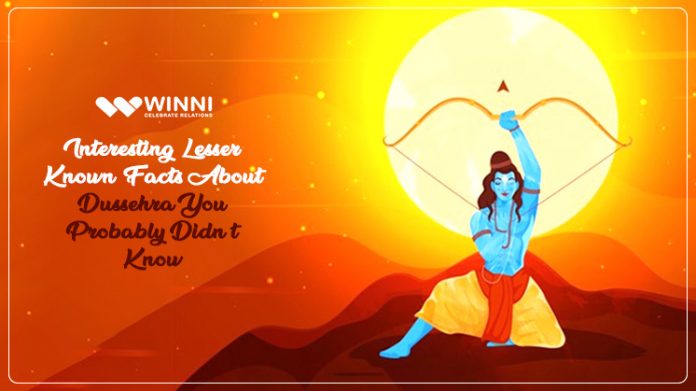Celebration of the triumph of good over evil, positivity over negative, truth over lies, wisdom over ignorance, and dharma over adharma can all be summed up and known as the festivity of Dussehra. It was the conquest of the victory of Lord Rama over the demon king, Ravana. Moreover, Dussehra marks the beginning of the long and beautiful festive season in India. Diwali is observed just 20 days after Dussehra. These are some basic facts about Dussehra and I am pretty sure, you must have been hearing many more stories and facts since your childhood about his festival, but here we have compiled some interesting and lesser known facts about the festival, you probably would not know!
- The origin of the name of Dussehra roots back to sanskrit Dash Hara wherein, the literal english translation is “the defeat of the Sun.” Hadn’t the Ravana been defeated, the sun would not have risen again.
- In some subcultures of Hinduism, the Dusshera is also known as Vijay Dashmi, which also means the victory on the 10th Day. The day is commemorated as the victory of Goddess Durga over the evil, Mahishasura.
- In Mysore, the day is celebrated by worshipping Goddess Chamundeshwari.
- Barley seeds are sown on the first day of Navratri in the Northern part of India. It is on the day of Dussehra, these sprouts are used and considered as the good omen that brings good fortune and prosperity.
- It is also believed that Goddess Durga and her children Kartik, Lakshmi, Ganesha, and Saraswati arrived at her birth place and had a stay for some time. It was on Dussehra, the Goddess returned to her husband Lord Shiva.
- It was for Goddess Durga’s return to her home, i,e Earth, many cultures practice their married or unmarried women to their homes.
- Dushera has its share of popularity throughout India, but it is the celebration of the festival particularly in Mysore that has gained the most popularity. The entire city is decorated with lights and colors. Since, they worship Goddess Chamuneshwari, a life size idol is taken out across the city.
- As per the Hindu mythology, Ravana’s 10 heads signifies his vast knowledge of 4 vedas and 6 shastras, and which is why Ravana was considered to be the most wise and learned man of his time. Moreover, his 10 heads also represented 10 human emotions such as ego, jealousy, anger, lust, greed, pride, injustice, attachment, selfishness and cruelty.
- Apart from the famous celebration of Dussehra in Mysore, the celebration of this festival in Kullu Himachal Pradesh has also caught the limelight. This festival is celebrated for about a week and people from various parts of the nation visit Kullu to be a part of this festival.
- Dussehra also marks the harvesting of Kharif crops and thereafter, Ravi crops are sown. Thus, it is also an important festival for the farmers.
- Dussehra also holds significance for Buddhism in India as on this day, Emperor Ashka had converted to Buddhism.
So, these were some interesting facts about Dussehra that is not known by many.




